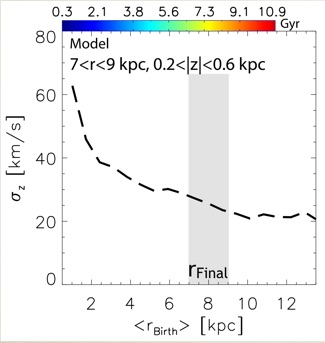How to recover the Milky Way merger history




Separate into [Fe/H] sub-populations
Unexpected decline in the velocity dispersion of RAVE giant stars





Stars close to the Sun are found to decrease their velocity dispersion at the high-[Mg/Fe] end. This result is unexpected because [Mg/Fe] is a proxy for age and older stars are expected to be kinematically hotter (i.e., to have higher velocity dispersion)
Self-similar behavior for all narrow [Fe/H] populations: a decline always found at the high-[Mg/Fe] end.
Comparison to a chemo-dynamical model
Very similar behavior found in our chemo-dynamical model (see Minchev, Chiappini, and Martig 2013)




We can see what causes this using our chemo-dynamical model
Looking at the dotted red lines in the 3 panels above, we can see that the velocity dispersion decline comes from older stars which were born in the inner disk. The lower the velocity dispersion, the older the stars and the further inside the disk they come from.
The peak in each velocity dispersion curve comes from the perturbations on the disk from infalling satellites (mergers), which heat the outer disk easily, while at the same time induce spiral arms and thus radial migration from the inner disk. Because kinematically colder stellar populations migrate more readily, the stars which arrive at the solar neighborhood are colder than the local ones. This causes the decline at the high-[Mg/Fe] end of each metallicity subpopulation.
When large stellar samples become available and precise chemistry measurements (Gaia + 4MOST + WEAVE data), we will be able to estimate
-
1.the mass and frequency of satellites perturbing the Milky Way disk throughout its life time from the peak in velocity dispersion of each metallicity subpopulation
-
2. the amount of radial migration induced by satellites (directly by their tidal pull and indirectly by strengthening the disk asymmetries) at a given cosmic time from the decline in velocity dispersion and the fraction of stars in the high-[Mg/Fe] end.
Age (top panel) and birth radius (bottom panel) as functions of [Mg/Fe] for stars in the same simulated solar neighborhood sample, which matches the RAVE data. Black dashed curves show the total population.
-
The above relation was also found in SEGUE G-dwarf stars (Minchev et al. 2013), in data from the Gaia-ESO survey (Guiglion et al. 2015), as well as in APOGEE giants (Minchev et al., in preparation).

Cold old stars arrive from the inner disk, causing the decline in velocity dispersion with [Mg/Fe]
Vertical velocity dispersion of stars currently in the simulated solar neighborhood (grey vertical strip centered on 8 kpc) plotted against stellar birth radius. Naively, it can be inferred from this plot that stars born in the inner disk constitute the hottest population at the solar radius today.

Colored curves indicate mono-age populations (stars grouped by common age). One can see that, for a given age group, stars arriving from the inner disk are cooler (have lower velocity dispersion) than stars born close to the solar radius. This is related to the effect of infalling satellites, which affect more strongly the outer disk (induce disk flaring), because of the low disk surface density there.
As mergers become less frequent and less massive at later times (orange line, ~8 Gyr old), the positive slope flattens and eventually becomes slightly negative (blue lines, ~2 Gyr old), suggesting that in the absence of mergers stars migrating outwards arrive slightly hotter than the local population. Note, however, that this does not mean that migration thickens the disk, since stars coming from the outer disk (inward migrators) cool the disk and thus cancel the effect of outward migrators (see Minchev et al. 2012b).

-
split the disk into groups of stars of common age
Stellar age [Billion years]


Mean stellar birth radius
Mean stellar birth radius